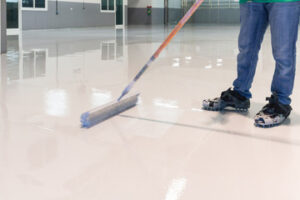Epoxy flooring is a great option for anyone looking to add value and beauty to their home. This durable material offers protection for your floors and is easy to install.

During the installation process, a layer of primer is applied to the floor. It helps improve adhesion and ensures a strong bond with the epoxy coating.
Epoxy flooring is one of the most durable floor solutions available. It is composed of several layers of resins, hardeners and curing agents that are combined to create a non-porous surface that can stand up to heavy foot traffic, impact damage and exposure to chemicals, oils and other substances. Epoxy is a thicker coating than regular paint solutions and can withstand much more wear and tear.
A properly installed and maintained epoxy floor coating can last 8 to 10 years in harsh industrial environments, offices and moderate commercial areas. The coating is also resistant to moisture and can be sealed every 5 years to maintain its durability.
The high-gloss finish of an epoxy floor helps to reflect existing lighting and brighten the space. This is particularly useful in residential garages and commercial showrooms that often struggle with poor light sources. In addition, it is easy to keep clean and does not require any special cleaners.
Regular sweeping and dust mopping can help to keep your floor looking its best. Additionally, spills should be cleaned immediately with a mild cleaning solution to prevent the growth of mold and bacteria that can cause health issues.
As they age, however, epoxy floors may become susceptible to damage from impacts like dropped tools in a garage or dropping equipment in an office. Regularly assessing your floor for damage and performing maintenance tasks like recoating when needed can extend its lifespan and protect your investment.
When installing an epoxy floor, proper preparation of the underlying concrete is vital to ensure that it will adhere correctly and provide a long-lasting, protective layer. It is recommended that you work with a professional to ensure the concrete is free of cracks, dirt and debris before applying the epoxy solution.
The cost of an epoxy floor is comparable to other flooring options. However, an epoxy floor is more durable and requires less maintenance, which means it will last longer and offer a higher return on investment. Additionally, it is an environmentally friendly option that complies with regulations set by USDA and FDA for food processing and distribution facilities.
Aesthetically Pleasing
Epoxy is a popular choice for flooring in residential homes, commercial spaces, and industrial buildings. It is easy to install and provides a hard-wearing surface that can withstand heavy loads and long-term use. It is also highly cost-effective. It is made up of resins and hardeners that create a solid, durable floor with little maintenance required.
It is available in a variety of colors that can match up with any design aesthetic, and decorative flakes can be added for an extra touch. It is also extremely versatile and can be used in a wide range of applications, such as automotive showrooms and commercial garages.
Another benefit of epoxy is that it creates an impermeable seal, making it water-resistant. This is beneficial for places that may experience spillage of chemicals or oil, as it prevents them from penetrating the underlying concrete and causing damage. It is also good for areas that could be exposed to flooding, as the epoxy will protect the underlying concrete from damage and can be easily cleaned.
The glossy finish of epoxy floors reflects light, giving your space an appealing appearance. This is a great feature in areas where natural lighting is limited, such as commercial showrooms and residential garages. The shiny floor also makes it easier to spot any damage or cracks in the surface and fix them quickly.
For a more practical application, epoxy can be made slip-resistant with material additives like vinyl flakes or sand, which will help to reduce the risk of accidents caused by people or vehicles moving over it. This is a good safety measure for any workplaces that might see a lot of foot traffic, and it can also help to improve traction for cars driving over the surface. The grit in the protective coating also helps to prevent any objects from sticking to the surface, so they can be removed with ease. This is especially useful in industrial spaces that need to maintain high standards of cleanliness and health and safety for their employees. It is also an affordable option that can be replaced with ease if damaged or worn down.
Easy to Clean
Epoxy floors are a huge financial investment and should be treated with the care they deserve. Routine cleaning not only keeps the floor looking beautiful but also prevents abrasions and surface damage. Regular cleaning will also help extend the lifespan of your epoxy floor.
Sweeping and vacuuming are a great way to keep your epoxy floor clean. You can also use a non-abrasive cleaner and rinse it off with water. Avoid using harsh chemicals and abrasive pads as they can damage your floor. A kitchen scrubbing sponge or deck brush can be used to scrub away any stubborn stains. Using a commercial degreaser such as Simple Green can also help remove stubborn grease or chemical spills without damaging the epoxy coating.
Another way to make your epoxy floor look better is by adding color chips or decorative designs. These can make your floor stand out and give it a more personal touch. This can be very beneficial in areas that receive a lot of foot traffic or in high-traffic hallways.
It is important to wipe up spills and stains promptly to prevent the contaminant from seeping through the epoxy and staining the floor. Keeping the floor protected with mats will also help to extend its life. A good practice is to sweep the floor before applying a second coat of epoxy. This will help to avoid sanding and reapplying the floor.
Epoxy flooring is a durable floor that looks good and is easy to maintain. It is a great choice for industrial environments, garages and living spaces. It is also highly recommended for any area that may have chemical or oil spills. If you have any questions about your epoxy floor, contact us. We will be happy to answer your questions and provide you with the best service possible.
Epoxy floor coatings are very attractive and can last for up to 20 years, but they do require some maintenance. The most important thing is to keep the floor dry and dust free, and this can be done by sweeping or vacuuming regularly. Using a commercial mops or hard foam mop and a gentle cleaning solution is also recommended. You should avoid using abrasive cleaners on your epoxy floor as it can scratch the surface. You should also use a non-slip additive for your floor to prevent it from becoming slippery.
Affordable
Epoxy flooring is more affordable than other floor coatings and provides a lot of bang for your buck. Depending on the size of your floor and the application method used, you can expect to spend between $5 and $12 per square foot to get your epoxy floors installed.
Despite the relatively high cost, it’s important to keep in mind that epoxy flooring is long-lasting and durable, which will ultimately save you money in the long run as it will reduce costly repairs and replacements. In addition, the unique metallic pigments and textures available with epoxy coating create a stunning effect that will make your floor look like polished concrete. This is one of the main reasons why epoxy has become more popular than traditional paint in commercial and industrial settings.
Before the installation of an epoxy floor, your concrete slab needs to be cleaned and prepared. This involves a process known as diamond grinding, media blasting, and jack hammers, among others. This is required to remove any contaminants from the slab surface and ensure that there are no cracks, chips, or other damages. Depending on the condition of your slab, you may need to patch some cracks before the epoxy can be applied.
The installation of an epoxy floor can take a few days. It’s also necessary to empty out the area that’s being worked on before the process begins. This can be costly, especially if you have to pay for a truck rental and temporary storage unit.
Unlike other types of floor coverings, epoxy is non-porous and completely waterproof. This makes it an ideal choice for areas that are likely to experience water spillage and flooding, as well as any commercial space that could be subjected to chemical spills. This will prevent toxins from getting absorbed into the substrate and help ensure that your facility adheres to all regulatory standards.
Aside from its longevity and durability, epoxy is a great option for flooring because it boosts visibility and brightens up your workspace. This is due to the way light reflects off its smooth surface. In addition, it can reduce the need for additional lighting in your workspace, further lowering operational costs.








